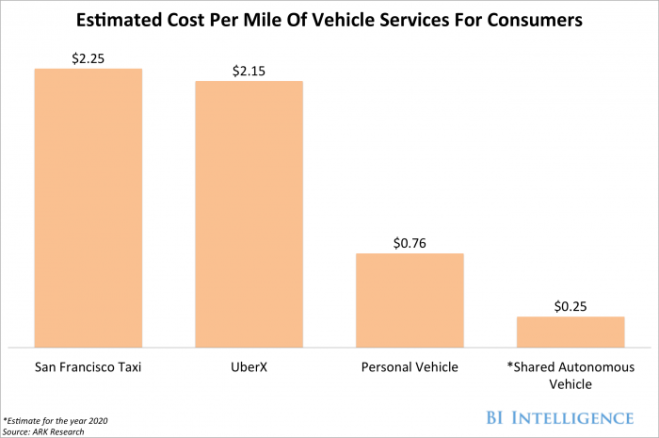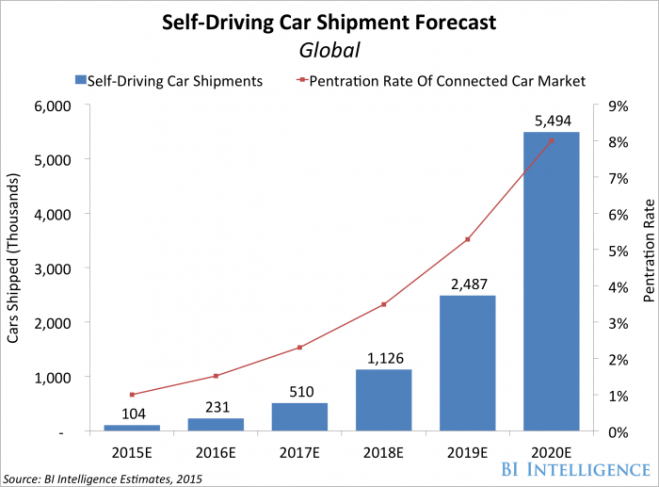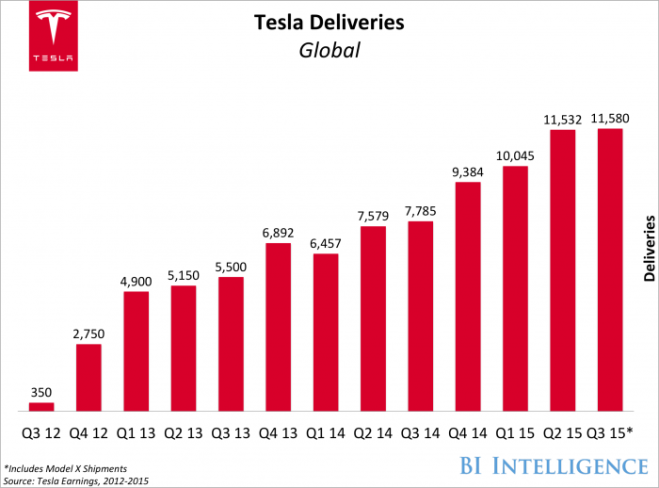Google will use self-driving cars to compete with Uber — California’s proposed regulations for self-driving cars — Z-Wave’s new security protocols
BI Intelligence
ALPHABET’S SELF-DRIVING CAR PROJECT WILL BECOME INDEPENDENT COMPANY NEXT YEAR: Alphabet’s business plans for its ongoing self-driving car project are becoming clear: the project will spin off next year into its own business, and that business will compete directly with Uber. Rather than selling self-driving cars to consumers, Alphabet (formerly Google) is going to offer a ride-hailing service similar to Uber with its self-driving cars, Bloomberg reported.
Uber has been working hard to develop self-driving cars for its own ride-hailing service. Self-driving cars would drastically lower costs for Uber rides to the point that it would be less costly for many consumers to take Uber rides everywhere instead of owning their own car. Asset management firm ARK Invest estimated earlier this year that self-driving cars would cut the cost of Uber rides to only 25 cents per mile. Uber has even hired a number of former Google employees to help with its own self-driving car efforts.
As Uber and others pour resources into developing self-driving cars, they’re all playing catch up to Google, which has been working on self-driving cars the longest. In the last six years, cars equipped with Google’s self-driving software have driven more than one million miles on the road. That means that Google’s software has more experience handling real-world obstacles and situations on the road than any other company’s self-driving technology right now. So Google is likely closer to delivering a ride-hailing service using self-driving cars than Uber is.
Although this could be bad news for Uber, it might be even worse news for automakers. If self-driving cars make ride-hailing services like Uber as cheap as ARK Invest predicts, it could make auto sales fall off a cliff. A Barclays analyst note earlier this year predicted that ride-hailing services combined with self-driving cars could reduce US auto sales by 40% in the next 25 years.

CALIFORNIA RELEASES SELF-DRIVING CAR REGULATIONS FOR THE PUBLIC: California’s Department of Motor Vehicles released a draft of proposed regulations that would allow self-driving cars to be used by the public on the state’s roads. This makes California the first state to propose legislation that would give consumers the right to ride in self-driving cars on public roads. Tech Insider provided a rundown of the proposed rules:
- The regulations won’t allow fully autonomous cars without a steering wheel: somebody would have to sit in the driver’s seat at all times, prepared to take the wheel if necessary.
- Anyone who wants to drive a self-driving car would have to take additional training beyond what’s included in normal driver’s license exams.
- The public also won’t be able to buy a self-driving car – they’ll have to lease them from the car manufacturer.
- Self-driving cars will also go through additional screening beyond normal safety certifications. Once a car passes the additional screening, it will get a three-year permit to operate in the state. During that three-year term, the manufacturer will need to provide a monthly report on the car’s safety, usage, and performance.
California was early in allowing self-driving car tests on its roadways. Google started testing self-driving cars in Mountain View, California back in 2009. The state is clearly trying to lead the way in becoming the first to propose rules to regulate the use of self-driving cars by consumers. Other states might look to California’s rules as a blueprint for their own self-driving car regulations. However, companies currently testing their self-driving cars in California might find these rules restrictive, and could look to take their self-driving car projects elsewhere if other states create more lenient regulations.
SMART HOME MESH NETWORK Z-WAVE IMPLEMENTS NEW SECURITY FRAMEWORK: Research has shown over the past year that many smart home devices are vulnerable to common cyber attacks. Z-Wave, one of the more popular mesh networks used to connect different smart home devices, is looking to relieve some of these security concerns with a set of new security features in its latest software development kit.
The security protections Z-Wave is issuing will help prevent hackers from compromising IoT devices to infiltrate home networks and steal consumers’ data. Those protections include strong encryption for any data sent over a Z-Wave network and secure exchange protocols that prevent hackers from stealing the encryption keys that protect that data. Without such protections, a hacker could infiltrate the home Wi-Fi network via the hub to steal data such as the homeowner’s financial credentials.
Z-Wave is already installed on more than 50 million smart home devices throughout the world including smart lights, smart thermostats, smart plugs, and hubs. Z-Wave is the second oldest mesh network designed specifically to serve the smart home besides Zigbee, it’s biggest competitor. Earlier this year, security researchers found a vulnerability in Zigbee’s communication protocols that allowed them to steal the encryption keys used to protect data sent over Zigbee networks. Z-Wave could be angling to promote its security as a competitive advantage over Zigbee, which has gained far wider acceptance so far than Z-Wave has.


